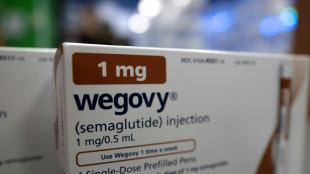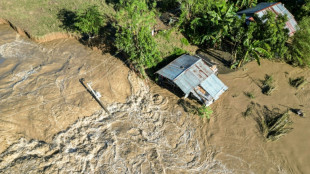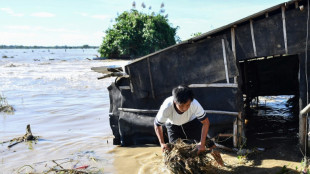
-
 Stocks sink on fears of Ukraine-Russia escalation
Stocks sink on fears of Ukraine-Russia escalation
-
Hendrikse brothers start for South Africa against Wales

-
 Macron tells Xi he shares desire for 'durable peace' in Ukraine
Macron tells Xi he shares desire for 'durable peace' in Ukraine
-
Ruthless Japan beat China to move to brink of World Cup qualification

-
 French farmers threaten 'chaos' over proposed EU-Mercosur deal
French farmers threaten 'chaos' over proposed EU-Mercosur deal
-
Brazil arrests G20 guards over alleged 2022 Lula assassination plot

-
 China's Xi urges 'strategic' ties in talks with Germany's Scholz
China's Xi urges 'strategic' ties in talks with Germany's Scholz
-
Raducanu gives Britain lead on Slovakia in BJK Cup semis

-
 Russia says Ukraine fired first US-long range missiles
Russia says Ukraine fired first US-long range missiles
-
COP29 negotiators strive for deal after G20 'marching orders'

-
 Walmart lifts full-year forecast after strong Q3
Walmart lifts full-year forecast after strong Q3
-
British farmers protest in London over inheritance tax change

-
 NATO holds large Arctic exercises in Russia's backyard
NATO holds large Arctic exercises in Russia's backyard
-
Trouble brews in India's Manipur state

-
 Son of Norwegian princess arrested on suspicion of rape
Son of Norwegian princess arrested on suspicion of rape
-
Romanian court says 'irregularities' in influencer Andrew Tate's indictment

-
 Iran faces fresh censure over lack of cooperation at UN nuclear meeting
Iran faces fresh censure over lack of cooperation at UN nuclear meeting
-
Despondency and defiance as 45 Hong Kong campaigners jailed

-
 Scholar, lawmakers and journalist among Hong Kongers jailed
Scholar, lawmakers and journalist among Hong Kongers jailed
-
European stocks slide on fears of Russia-Ukraine escalation

-
 Police break up Georgia vote protest as president mounts court challenge
Police break up Georgia vote protest as president mounts court challenge
-
Spain royals visit flood epicentre after chaotic trip

-
 France's Gisele Pelicot says 'macho' society must change attitude on rape
France's Gisele Pelicot says 'macho' society must change attitude on rape
-
G20 leaders talk climate, wars -- and brace for Trump's return

-
 US lawmaker accuses Azerbaijan in near 'assault' at COP29
US lawmaker accuses Azerbaijan in near 'assault' at COP29
-
Tuchel's England have 'tools' to win World Cup, says Carsley

-
 Federer hails 'historic' Nadal ahead of imminent retirement
Federer hails 'historic' Nadal ahead of imminent retirement
-
Ukraine vows no surrender, Kremlin issues nuke threat on 1,000th day of war

-
 Novo Nordisk's obesity drug Wegovy goes on sale in China
Novo Nordisk's obesity drug Wegovy goes on sale in China
-
Spain royals to visit flood epicentre after chaotic trip: media

-
 French farmers step up protests against EU-Mercosur deal
French farmers step up protests against EU-Mercosur deal
-
Rose says Europe Ryder Cup stars play 'for the badge' not money

-
 Negotiators seek to break COP29 impasse after G20 'marching orders'
Negotiators seek to break COP29 impasse after G20 'marching orders'
-
Burst dike leaves Filipino farmers under water

-
 Markets rally after US bounce as Nvidia comes into focus
Markets rally after US bounce as Nvidia comes into focus
-
Crisis-hit Thyssenkrupp books another hefty annual loss

-
 US envoy in Lebanon for talks on halting Israel-Hezbollah war
US envoy in Lebanon for talks on halting Israel-Hezbollah war
-
India to send 5,000 extra troops to quell Manipur unrest

-
 Sex, drugs and gritty reality on Prague's underworld tours
Sex, drugs and gritty reality on Prague's underworld tours
-
Farmers descend on London to overturn inheritance tax change

-
 Clippers upset Warriors, Lillard saves Bucks
Clippers upset Warriors, Lillard saves Bucks
-
Acquitted 'Hong Kong 47' defendant sees freedom as responsibility

-
 Floods strike thousands of houses in northern Philippines
Floods strike thousands of houses in northern Philippines
-
Illegal farm fires fuel Indian capital's smog misery

-
 SpaceX set for Starship's next flight, Trump expected to attend
SpaceX set for Starship's next flight, Trump expected to attend
-
Texans cruise as Cowboys crisis deepens

-
 Do the Donald! Trump dance takes US sport by storm
Do the Donald! Trump dance takes US sport by storm
-
Home hero Cameron Smith desperate for first win of 2024 at Australian PGA

-
 Team Trump assails Biden decision on missiles for Ukraine
Team Trump assails Biden decision on missiles for Ukraine
-
Hong Kong court jails 45 democracy campaigners on subversion charges

| RBGPF | -0.74% | 59.75 | $ | |
| RYCEF | 1.15% | 6.93 | $ | |
| SCS | -0.84% | 13.09 | $ | |
| BCC | -1.44% | 139.53 | $ | |
| RIO | -0.4% | 61.875 | $ | |
| NGG | 0.65% | 63.31 | $ | |
| CMSD | -0.08% | 24.37 | $ | |
| VOD | -0.62% | 8.865 | $ | |
| RELX | 0.04% | 45.06 | $ | |
| BCE | -0.17% | 27.185 | $ | |
| AZN | 0.17% | 63.5 | $ | |
| GSK | -0.85% | 33.405 | $ | |
| JRI | 0% | 13.23 | $ | |
| BP | -1.19% | 29.075 | $ | |
| BTI | -0.25% | 36.59 | $ | |
| CMSC | -0.02% | 24.62 | $ |

Waste into gold: Oyster shells repurposed as magic 'Seawool'
Growing up on Taiwan's west coast where mollusc farming is popular, Eddie Wang saw discarded oyster shells transformed from waste to function -- a memory that inspired him to create a unique and environmentally friendly fabric called "Seawool".
Wang remembered that residents of his seaside hometown of Yunlin used discarded oyster shells that littered the streets during the harvest as insulation for their homes.
"They burned the shells and painted the residue on the walls. The houses then became warm in the winter and cool in the summer," the 42-year-old told AFP at his factory in Tainan.
"So I was curious about why oyster shells have such a miraculous effect."
Wang's Creative Tech Textile company, established in 2010, was already producing an "eco-fabric" -- a polyester material made out of recycled plastic bottles -- but he felt its texture was a bit "ordinary".
So he started working with a research institute to experiment making fabric out of the oyster shell residue, in 2013 coming up with the right formula that produces a material similar to wool.
Today, his factory in Taiwan uses around 100 tonnes of oyster shells a year to churn out around900 tonnes of Seawool,a trademarked and patented fabric.
The fabric and clothing generate around NT$200 million (US$6.1 million) a year, with the bulk of it sourced by outdoor and sustainability clothing brands in Europe and the United States.
The Made-in-Taiwan fabric would not be possible without the island's unique oyster farming culture, Wang said.
- 'A magical yarn' -
"This industry chain cannot be found anywhere else overseas," he says.
"We have people to harvest oysters, we have specialists to clean oyster shells, and we have people for drying and calcining (treating) oyster shells."
The small island of Taiwan has a hefty appetite for oysters, harvesting an estimated 200,000 tonnes a year with the fleshy meat appearing in local cuisine such as crispy omelettes and silk-like noodle dishes.
But its popularity also means that about 160,000 tonnes of shells are discarded yearly, according to data from the agricultural ministry.
They pile up on the streets of aqua-farming towns -- the majority in western cities such as Yunlin, Changhua and Chiayi -- causing environmental issues by emitting fishy smells and providing breeding sites for mosquitos.
At Wang's factory, the shells are ground into nano beads and combined with yarn made from recycled plastic bottles.
"It creates a magical yarn," he said. "Oyster shell is a material with low thermal conductivity -- it does not absorb heat nor does it dissipate heat."
Turning the shells -- which capture and store carbon dioxide from the atmosphere -- into Seawool also does not require water, making it a "low-carbon product," said Wang.
A half-hour drive from his showroom where activewear jackets, sweaters and pants are displayed, state enterprise Taiwan Sugar Corporation (TSC) also has a factory that grinds discarded shells into a powder that is used in manufacturing household items, like incense sticks.
The crushed shells help to reduce smoke and the toxic chemicals emitted from burning incense, said Chen Wei-jen, deputy chief of TSC's biotech business division.
- From waste to gold -
"We hope oyster shells can have multiple industrial applications and interested companies can use it as a raw material to make their products more environmentally friendly and add value to their products," Chen said.
Before the shells get to the factories, farmers in Chiayi -- a county famed for producing oysters -- collect the molluscs at dawn from racks installed along the coast.
They are sorted into baskets before being sent to plants such as Dai Sen-tai's factory, where they are machine-washed before being sent to small family-run businesses that shuck the meat and send the shells south.
Dai, whose family have been in the oyster farming industry for three generations, said he is happy that Taiwan is breathing new life into the sea waste.
"When I was a child, no one wanted oyster shells -- they were dumped and discarded everywhere," he told AFP.
"It's good that the waste has been turned into gold now."
A.Taylor--AT


